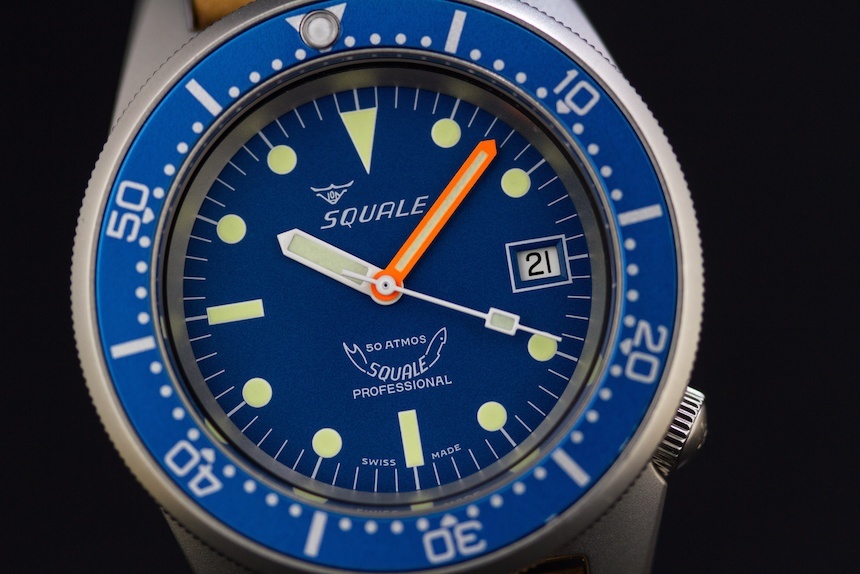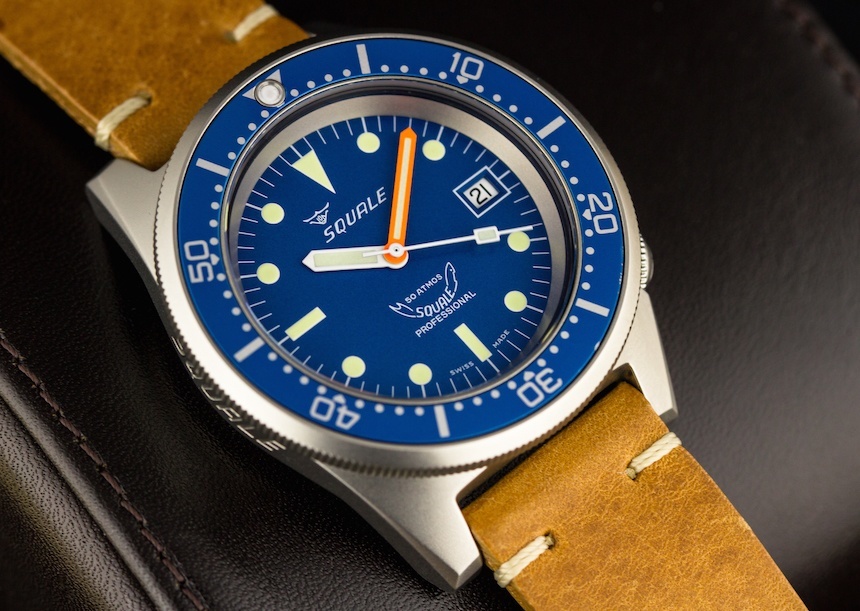
Born in Switzerland and now based in Italy, Squale exclusively produces dive watches, and they have a fascinating history to bolster their legit chops in dive watch design. While they don’t have a huge reach in North America, I met up with Squale at Baselworld and borrowed a strikingly blue Squale 50 Atmos Ocean Blasted 1521-026, one of the latest iterations of their beautifully-proportioned Squale 50 Atmos dive line and an excellent introduction to this quiet but intriguing brand.
Watch brands cling to their history, both real and otherwise, as though it’s the only way they could convince you or I to buy one of their watches. In an industry that often pushes brands to oversell their lineage, Squale has an interesting and colorful past that should appeal to both divers and more casual fans that like legacy design and a family story. Capable of tracing their history back to the late 40’s, Squale started as von Buren SA, founded by Charles and Helene von Buren in Neuchatel, Switzterland. Charles was interested in scuba diving, and by 1959, they were producing their own dive watch cases. The Squale brand was officially launched in 1962 and continued to produce cases and watches for a number of other brands, with the Squale logo placed on the dial. Squale’s clientele included not only brands like Heuer, Blancpain, and even DOXA, but also military units like Italy’s Folfore Brigade and the French Commandos Marine.
Though production continued into the late ’80s, Squale was hit by the death of Charles von Buren and the scourge of the Quartz Crisis. As luck would have it, Squale’s Italian distributor (and family friends) the Maggi family bought the brand and brought it back to market in 2010. Production remains in Neuchatel, and Squale is still very much a family business – with close ties to Charles’ daughter, Monique von Buren. Today, with Andrea Maggi as CEO, Squale’s classic appeal feels entirely on point and their modern product line nicely echoes their roots in the early days of sport and professional scuba diving.

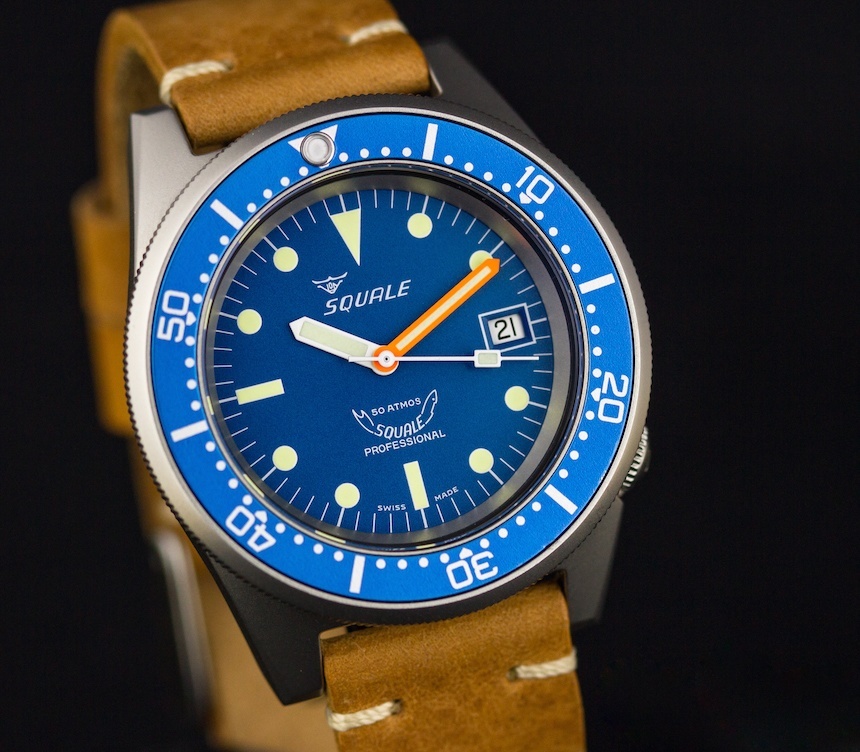
So how does all of that translate to the product? The Squale Ocean Blasted 1521-026 diver is part of the 50 Atmos line and is essentially an alternate version of Squale’s Professional 1521-026 diver, having been modified with a bead-blasted case and a matte blue dial and bezel. By my count, Squale produces the better part of ten versions of the Squale 1521-026, so if the blue and blasted isn’t to your liking, you can see other iterations here and likely find a combo to suit your wrist. The design is simple but tuned for sport, offering excellent legibility and an overall aesthetic that has endured since the classic years of diving. The Squale 50 Atmos case style, also known as the “von Buren case,” is water resistant to 500M (1640ft or 50 atmospheres of pressure).
The case is not like anything I’ve encountered, especially at this price point. The design is multifaceted, ergonomic, and highly functional. The matte bead blasted case looks amazing, especially when paired with the matte blue dial. The finish is even, flat, and soaks up available light in a manner similar to brushed titanium.
Some Instagram comments uncovered a bit of missing information as to case sizing, so here are my measurements using a digital caliper. The case width is 40.4mm wide, the bezel is 42mm across with a slight overhang that looks great and allows for an excellent grip profile. Thickness is 13mm and the lug-to-lug is a wrist-friendly 49 mm. At 109g on Squale’s included strap, the Squale 50 Atmos Ocean Blasted 1521-026 wears perfectly on my 7-inch wrist. Its combination of curved lugs and light weight make for a very fuss-free wrist feel and, for my tastes, the proportions are perfect. I love the slightly thinner case profile for both general comfort and accessibility when using the bezel while wearing gloves.
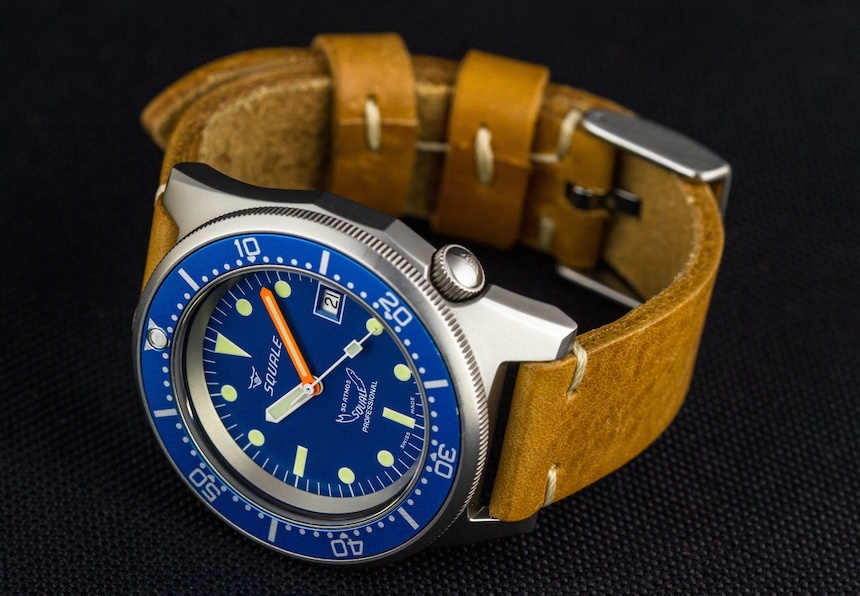
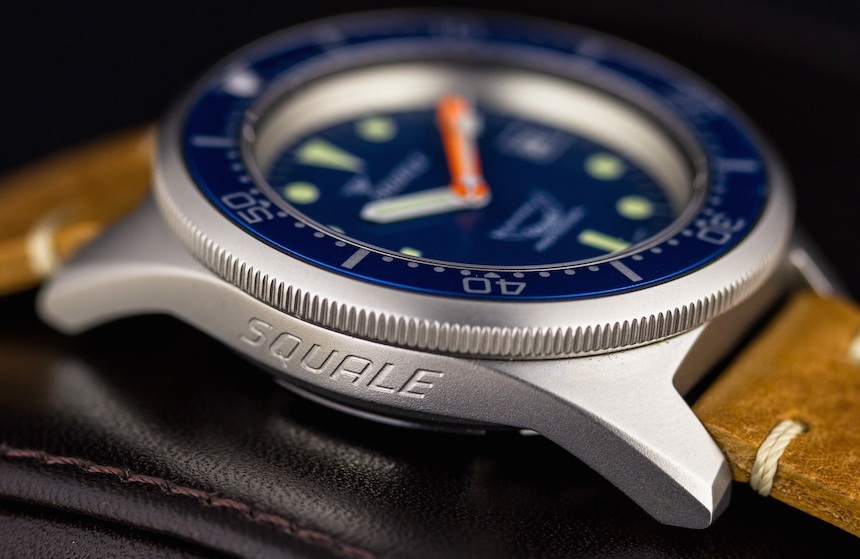
The left flank of the case carries the Squale name, and while I didn’t initially care for the additional branding, I found it to be more subtle than expected, and I came to appreciate its inclusion, especially given Squale’s history as a case producer. The right side of the case houses the screw down crown at four o’clock where the base of the lug meets the case. While this makes for a cumbersome experience when adjusting the crown (more on that later), it’s a defining element of the Squale 50 Atmos design.
Next to the crown, the case is faceted in a way I’ve not seen before. The facets, much like the engraved naming on the left side, are not easily visible from the wrist, but somehow add to the allure of this fun Italian diver. The lug spacing is 20mm and the lug shape is direct with an almost military appeal (not unlike the lug profile of Benrus Type I and II watches). The lugs are crisp on the underside and beveled on the upper/outer edge, an excellent and simple addition to the case finishing that looks more refined than a hard edge.
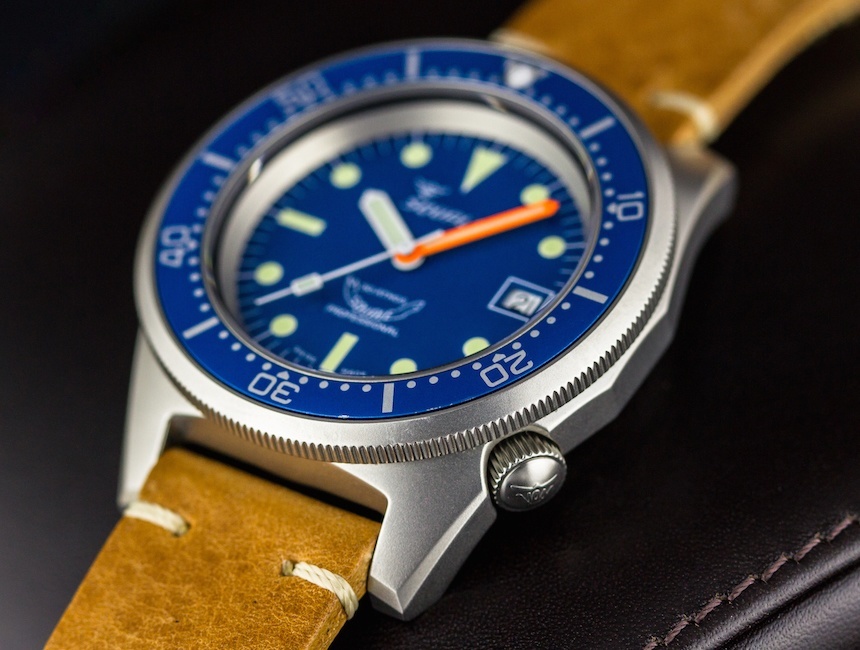
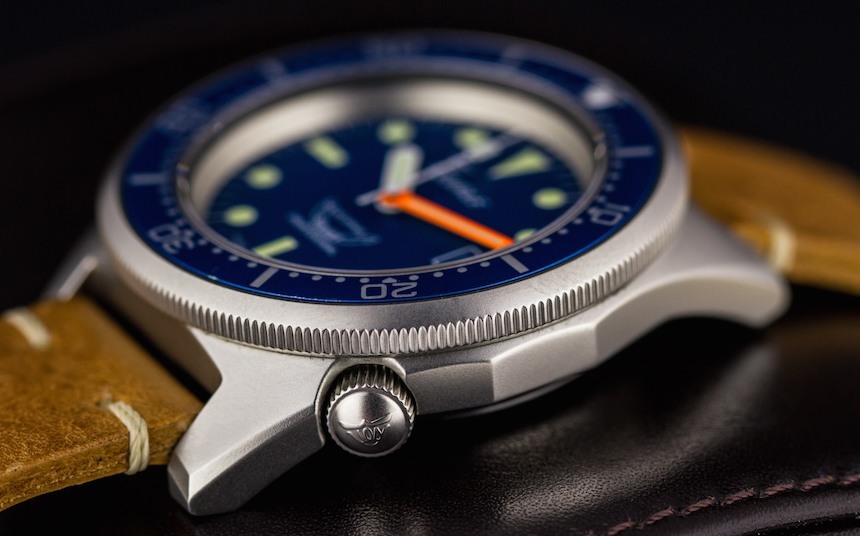
The 60-click bezel features a coin edge, lume pip at twelve and a traditional one hour elapsed time dive scale. While the action is impressively light and fast, the bezel is quite secure and features minimal wiggle between clicks, though some movement is so be expected with a 60-click bezel (due to the larger space between clicks). In day-to-day use, the Squale 50 Atmos Ocean Blasted 1521-026’s bezel action was light enough that I could set it with only the pressure of my thumb and the the tightness of the strap against my wrist. With such a light action, I did experience some accidental bumps and would occasionally find the bezel at 59 minutes rather than 60, thus igniting my OCD. I am not sure if I simply had a model with a lighter bezel spring or if this is common to all 1521s, but a slightly heavier action would not be unwelcome.
Both the bezel and the dial are a remarkably fluid shade of blue. Being somehow both matte and iridescent, the shade and intensity of the blue reflects that of the available light. While direct light reveals a lighter shade and causes the bezel to exhibit a metallic glow, lower light reveals a more azure shade, and the bezel appears to be the same color and finish as the dial. Legibility is strong in any situation, with the view through the nearly invisible flat anti-reflective sapphire crystal bolstered by a luminous treatment that is surprisingly bright despite the Squale 50 Atmos Ocean Blasted 1521-026’s smaller markers and hands. As an elapsed dive bezel is read with the minute hand, the Squale 50 Atmos Ocean Blasted 1521-026 sports an orange minute hand that looks amazing over the blue tones of the dial. The date window at three features a black on white display that is easy to read, and additional attention has been given to the date aperture where both a simple white box surrounds the window and the edges have been beveled. This is a level of attention to detail that is quite rare in the date window game at this price point.
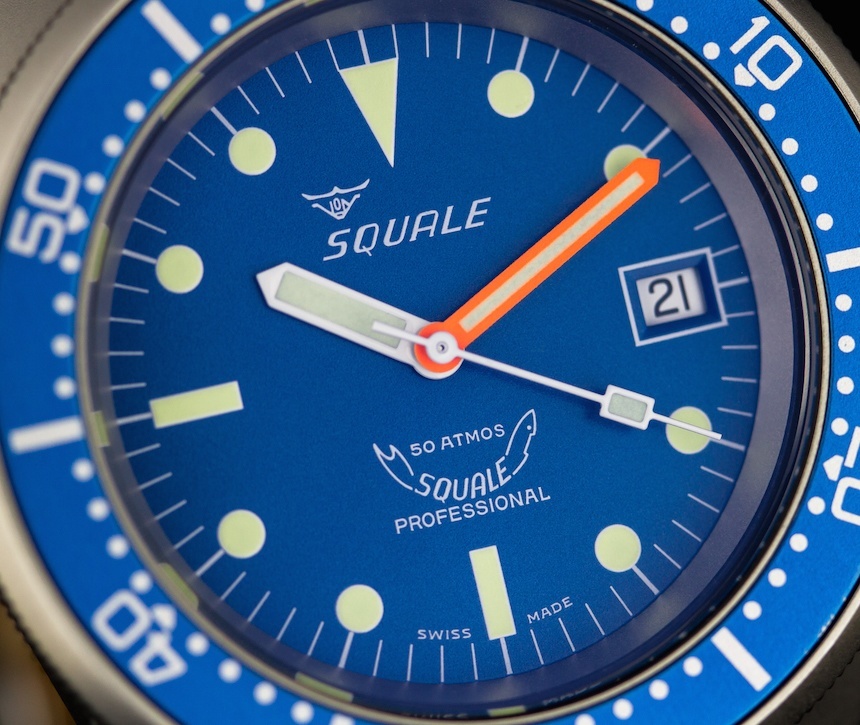
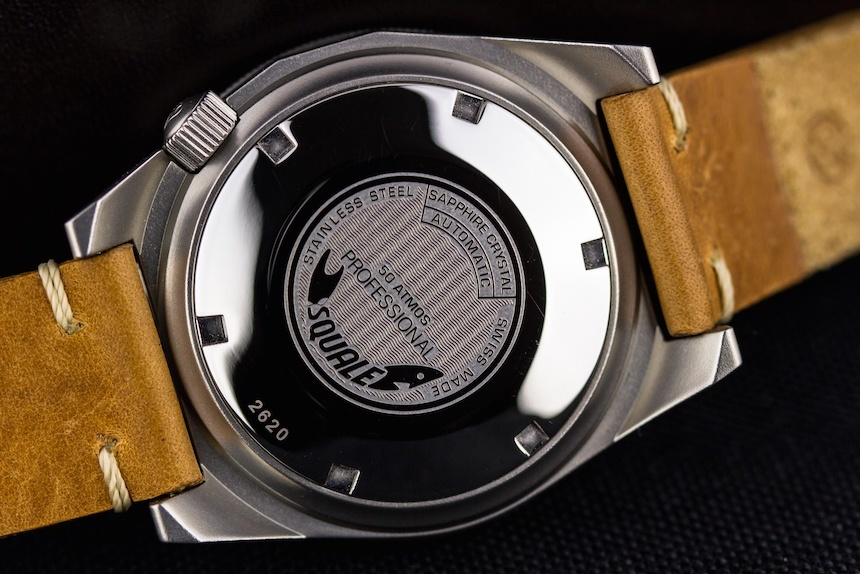
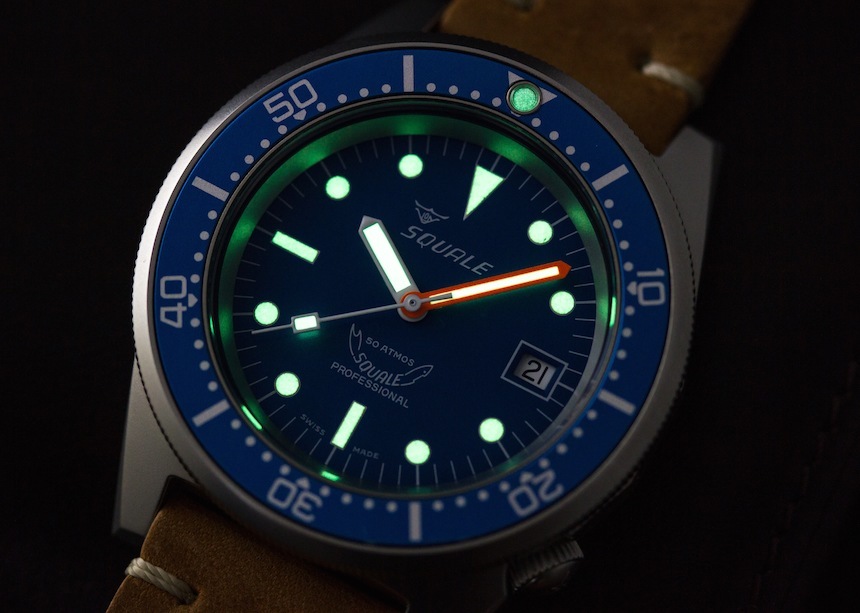
Lume is also a strong point for the Squale, with both the hands and dial markers capable of a strong and lasting glow that befits a dive watch. I did, however, find the grip and the action of the crown to be somewhat difficult and a little annoying. When screwing or unscrewing the crown, the grooved lines (cut into the edge of the crown for grip) often rub against the edges of the surrounding case. Once unscrewed, the crown’s action is both quite heavy (requiring more effort than you’d expect) and not especially communicative, leading to some difficulty moving it between the winding, date, and time-setting positions. This being said, the Squale exhibits no slop and little wobble in the crown, with threading that is both positive and smooth.
The Squale 50 Atmos Ocean Blasted 1521-026 uses an ETA 2824 automatic movement, a reliable, easily serviced and entirely appropriate Swiss movement that is quickly becoming rare in watches under $1000 (especially from smaller brands that can’t match the buying power of the bigger names). Timekeeping was well within the acceptable range, and with more and more of Squale’s competitors opting for the often cheaper and easier to source Miyota 9015, the continued inclusion of an ETA 2824 is noteworthy.
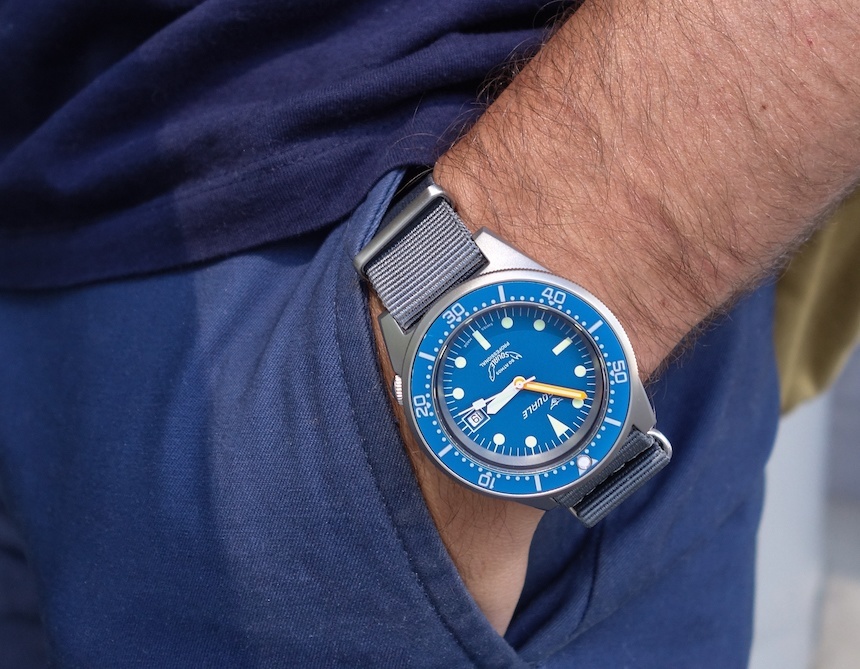
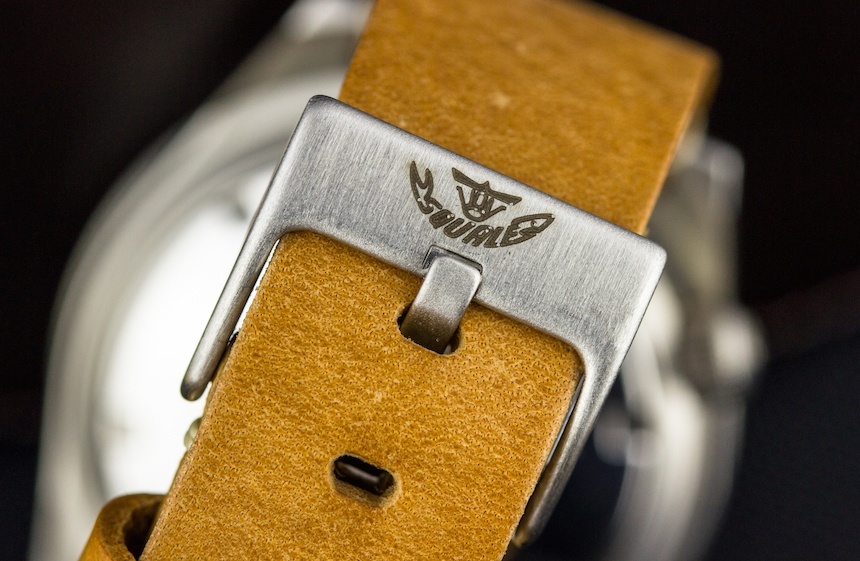
I took the Squale 50 Atmos Ocean Blasted 1521-026 diving in local waters of Vancouver at a wreck site called Porteau Cove. Despite being a bright and crystal-clear day above water, the submarine environment was rather murky. Even in 10ft of viz, the Squale not only looked the part, but the bezel proved easy to operate with thick gloves and even easier to read at a glance throughout my dive. While I did have to modify a spare nato for use as a dry-suit extension, the Squale 50 Atmos Ocean Blasted 1521-026 (on a Squale rubber strap) could not have looked more at home among the intimidating Lingcods, countless crabs, and the plumose anemone that line the hull of the sunken Granthall. With our dives maxing out around 21m (68 feet), I didn’t come close to the Squale 50 Atmos Ocean Blasted 1521-026’s super-human 500M water resistance. Please see the included video review for some footage from my Squale dive.
As I mentioned above, the Squale 50 Atmos case is fantastic on-wrist. It’s light, curved, comfy and feels born of a time when diving was still an extreme sport. The case shape and short lugs make it comfortable on a variety of straps, and Squale offers everything from the pictured leather to a variety of rubber straps and even a mesh bracelet. Whether you prefer the blue bead-blasted variety shown here or one of the other versions, the Squale 50 Atmos Ocean Blasted 1521-026 is a compelling package. Given the size, the history of the Squale 50 Atmos design and the range of versions available, I really like the Squale 50 Atmos Ocean Blasted 1521-026. While competition at the $250-1000 price point gets hotter by the year, the Squale stands out with with a distinctive case design, excellent legibility, a reliable movement, and an entirely charming and rather old-school wrist presence that isn’t simply a callback to past designs for the sake of generating “vintage” appeal.
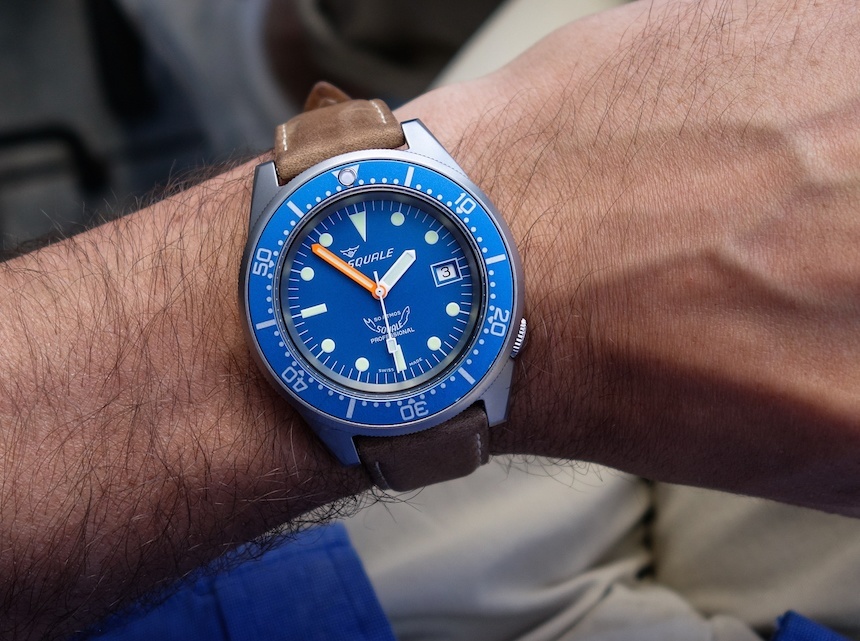
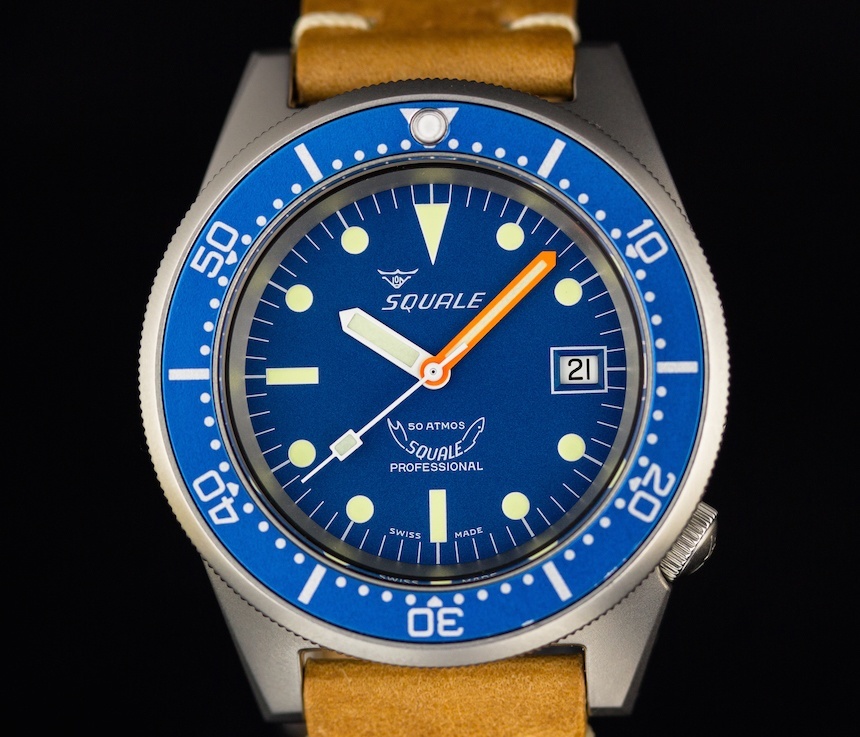
Being a small brand, most of your purchase options are online and Squale sells both through their own Italy-based website and a number of worldwide authorized dealers (check Gnomon if you’re in the US). Squale retails the Squale 50 Atmos Ocean Blasted 1521-026 for 648 Euros, which is roughly $725 USD before shipping and taxes (a price made somewhat lower thanks to recent currency changes). Assuming roughly $800 – $900 to your wrist, the Squale has plenty of competition from other micro brands and even bigger players like Citizen and Seiko. Few are going to be able to trace the history of a modern design as far back as the ’50s and, marketing aside, the Squale 50 Atmos 1521-026 has an appeal and aesthetic that links it with a very romantic era, the birth of diving, and the heyday of tool dive watches. In the most rudimentary of concepts, Squale is not all that different from Rolex, Blancpain, or Doxa, who developed a tool-derived dive watch design that has managed to weather the storm of public trends, the end of analog diving, and the casual death of the tool watch. Sure, Squale is much smaller, operates in a different price point, and uses third-party movements (like Doxa), but they are also drastically more affordable than much of their historic competition. If you’re a dive watch fan with an eye for legacy designs and proper history, you’ll be hard-pressed to find a better value than Squale. squale.ch, squalewatches.com
Necessary Data
>Brand: Squale
>Model: 1521-026 Ocean Blasted (50 Atmos)
>Price: 648 EUR (price varies by locale)
>Size: 42mm
>Would reviewer personally wear it: Yes.
>Friend we’d recommend it to first: Anyone who appreciates a dive watch.
>Best characteristic of watch: Case design and comfort.
>Worst characteristic of watch: Difficult crown implementation.

